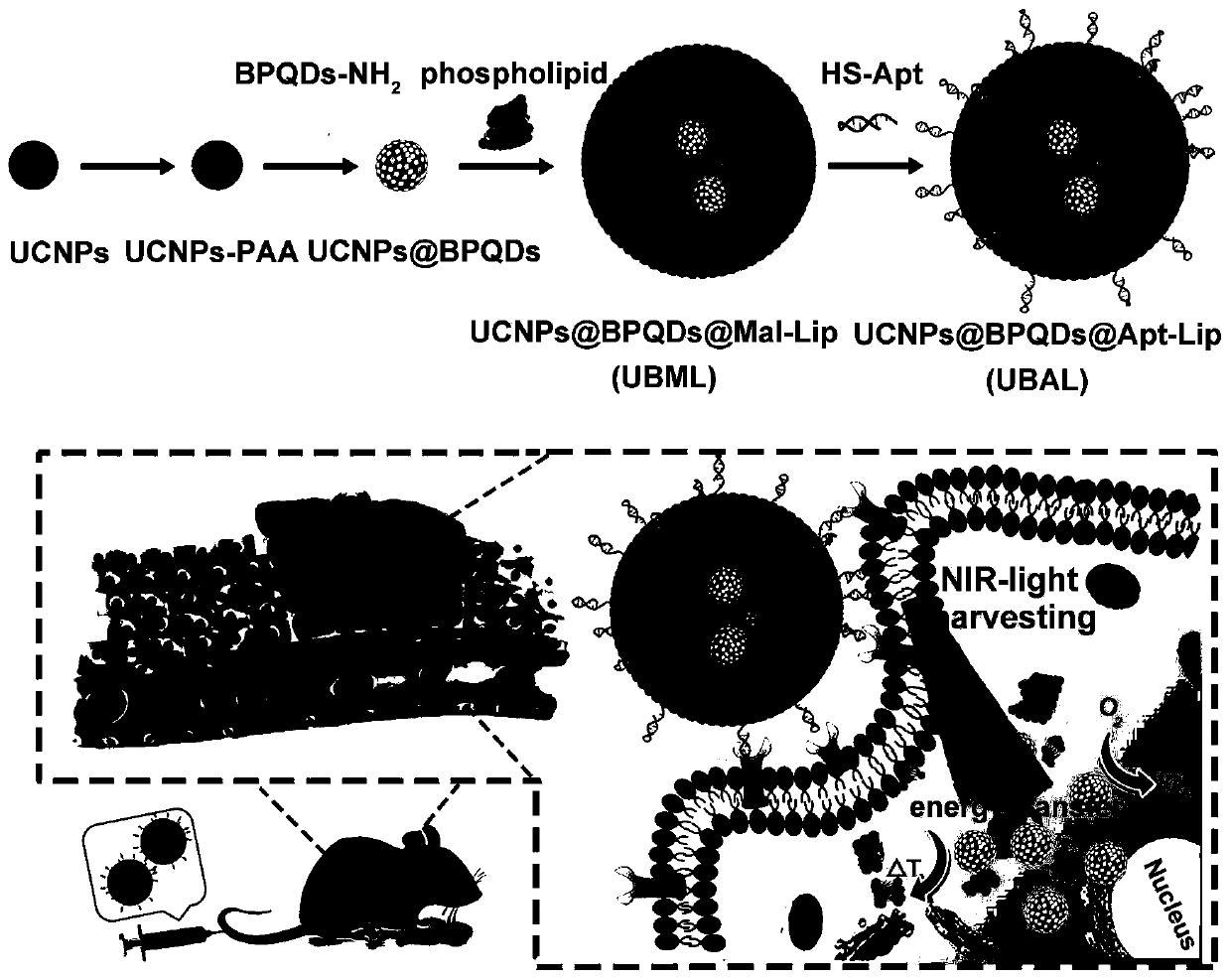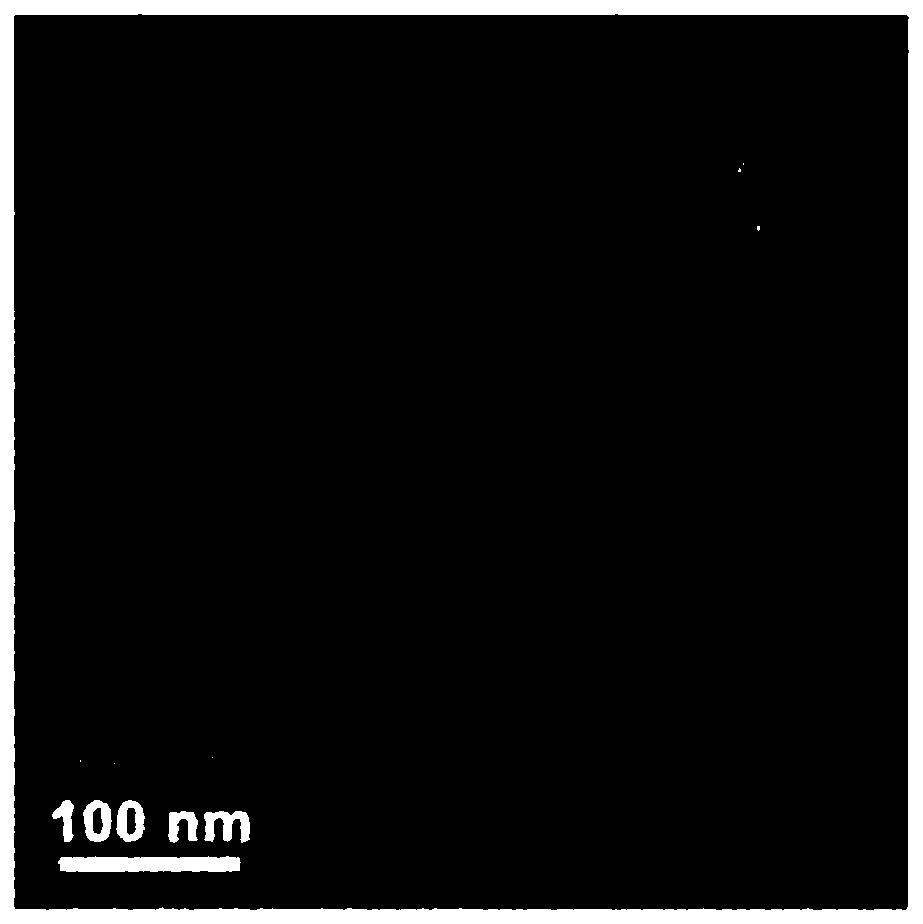Near-infrared light-responsive nano-liposomes, preparation method of near-infrared light-responsive nano-liposomes, and application in synergetic treatment of tumors
A near-infrared photoresponse and nano-liposome technology, which is applied in liposome delivery, antineoplastic drugs, photodynamic therapy, etc., can solve the problems of poor biocompatibility, pharmacokinetics and efficacy of photothermal agents and photosensitizers Poor dynamics, sunlight cannot be used and activated, etc., to achieve the effect of avoiding normal cell and tissue damage, good biocompatibility, and significant therapeutic effect
- Summary
- Abstract
- Description
- Claims
- Application Information
AI Technical Summary
Problems solved by technology
Method used
Image
Examples
Embodiment 1
[0053] Example 1: Preparation and characterization of nanoliposomes (UCNPs@BPQDs@Apt-Lip, UBAL) based on upconversion@black phosphorus near-infrared photoresponse:
[0054] (1) Add 30mL of diethylene glycol (DEG) and 300mg of PAA into a 100mL three-neck flask, heat it to 110°C under vacuum, slowly add 100mg of UCNPs nanoparticles dispersed in toluene solution into the flask and under the protection of argon Reaction 1h. The solution was then heated to 240 °C and the reaction was continued for 1.5 h. After cooling to room temperature, ethanol was added to obtain the precipitation of UCNPs-PAA.
[0055] (2) Add 200 mg of block BP to 300 mL of N-methyl-2-pyrrolidone (NMP). Under the protection of argon, use an ultrasonic cell disruptor (ultrasonic frequency: 19-25kHz) to sonicate in an ice / water bath for 8h (2s, with an interval of 0.1s) and then continue to sonicate for 10h (2s, with an interval of 4s) to obtain a brown solution. Centrifuge at 7000rpm for 20min to remove unst...
Embodiment 2
[0064] Example 2: Biocompatibility of UBAL near-infrared light-responsive nanoliposomes in vivo:
[0065] Healthy female Kunming rats (20 g) were injected with 100 μL of 5 mg / kg, 10 mg / kg, and 25 mg / kg of UBAL into the tail vein respectively, and 100 μL of normal saline was used as a negative control. The mice were weighed every 2 days (mouse body weight-time curve). After 28 days, the mice were killed, and 0.8 mL of blood was collected from each mouse for blood routine and blood biochemical analysis, and the main organs of each mouse were collected, fixed in 10% neutral formalin, embedded in paraffin, and sectioned with a thickness of 8 μm , stained with hematoxylin and eosin, and observed with a digital microscope.
[0066] In vivo biocompatibility can further characterize the potential of UBAL in clinical translation. Routine testing of blood was performed after one month of feeding, and biopsies were evaluated by hematoxylin and eosin (H&E) staining. From Figure 9 It ...
Embodiment 3
[0067] Example 3: UBAL near-infrared light-responsive nanoliposomes can be used for tumor tissue fluorescence imaging, tumor photokinetic and photothermal therapy:
[0068] (1) 4-week-old female Balb / c nude mice (18-20g) were inoculated with tumors, suspended in DPBS at a density of 1×10 7 Breast cancer cells were injected subcutaneously into the right upper limb of each female Balb / c mouse. On day 5 after tumor cell injection, tumor growth was evident.
[0069] (2) Balb / c nude mice were intravenously injected with UBAL and UBCL (100 μL 5 mg / mL per nude mouse), and 808nm NIR light was used as the excitation source for in vivo fluorescence imaging, and the mice were imaged at different times with a fluorescence imaging system. Such as Figure 11 As shown, when UBAL was injected into mice bearing 4T1 tumors through the tail vein, obvious fluorescent signals could be seen at the tumor site, and the signal intensity reached the maximum at 2 h. Signal intensity was dim and disap...
PUM
| Property | Measurement | Unit |
|---|---|---|
| diameter | aaaaa | aaaaa |
Abstract
Description
Claims
Application Information
 Login to View More
Login to View More - R&D
- Intellectual Property
- Life Sciences
- Materials
- Tech Scout
- Unparalleled Data Quality
- Higher Quality Content
- 60% Fewer Hallucinations
Browse by: Latest US Patents, China's latest patents, Technical Efficacy Thesaurus, Application Domain, Technology Topic, Popular Technical Reports.
© 2025 PatSnap. All rights reserved.Legal|Privacy policy|Modern Slavery Act Transparency Statement|Sitemap|About US| Contact US: help@patsnap.com



